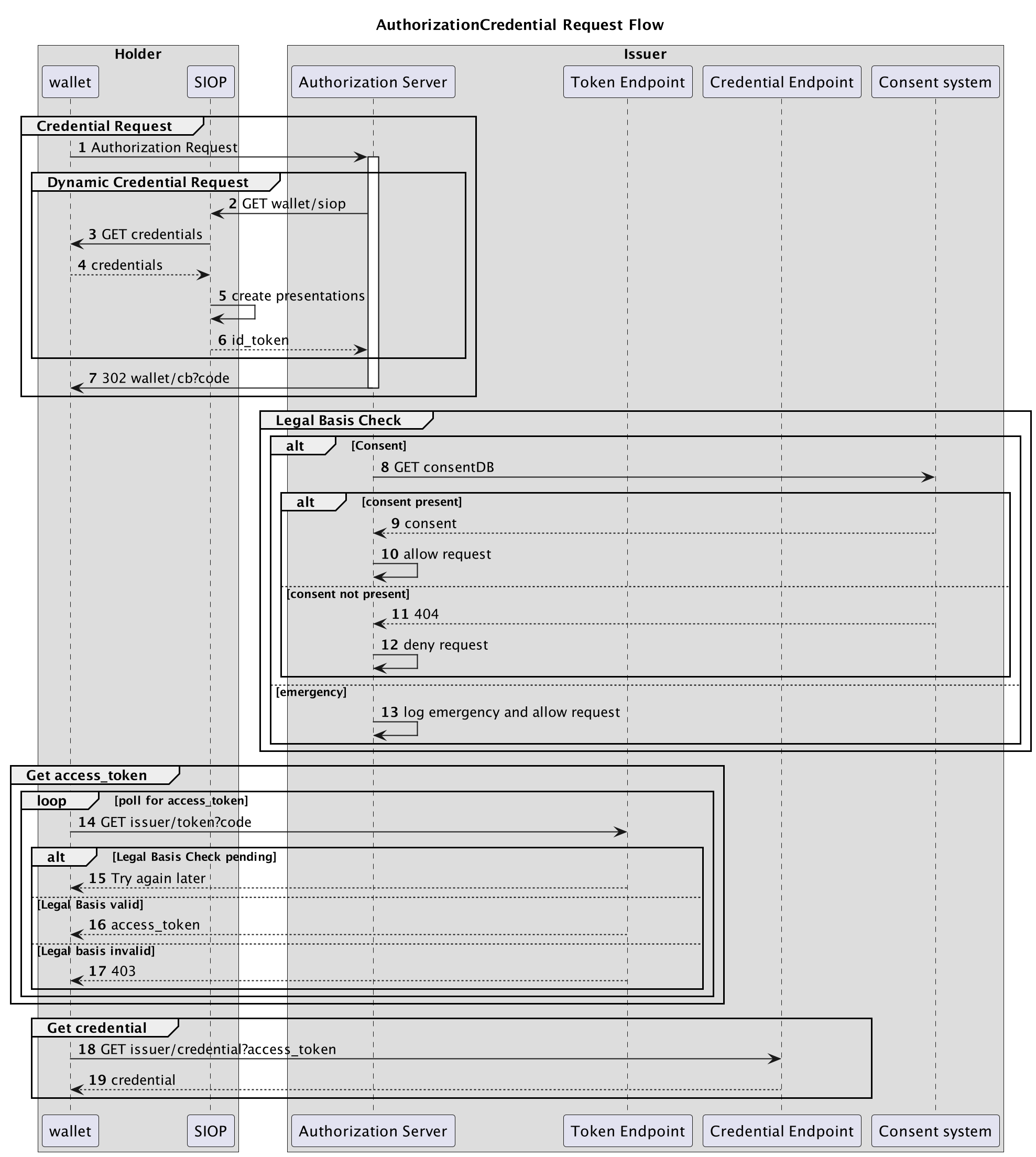Authorization request
Note: Work in progress!
The process of requesting the authorization to perform operations on a set of resources. The custodian must check if all the requirements are met, therefore the response will be a-sync.
Relevant standards
Terms
The following information is needed:
scope The scope of the authorization request. In case of patient data, a patient identifier such as a BSN should be provided.
legal-basis A set of legal basis which can be used to grant the request. Examples: implied consent, explicit consent, legal task, emergency.
custodian Party who has the legal obligation to keep the data safe and only share under certain conditions.
requestor Party who wants to perform the operations on the data.
Use-case
A GP wants to read a report about a patient written by a caregiver at another care organization (custodian). The GP requests access to this report(scope). The custodian needs a patient consent in order to grant this request. It will look into its own consent system(s) to find it. If it is there, the GP receives an authorization in the form of a AuthorizationCredential.
Implementing using the OIDC4VCI credential request
We will base the implementation based on the new OpenID Connect standard. This way wallets and issuers will interact in a standardized way which makes this solution interoperable with other wallets and issuers.
The interactions are shown in the following diagram:
The issuer is the Custodian and the Holder is the Requestor (GP in our use-case example).
Let's walk through all the steps:
Credential Request
The goal for this group is the Requestor asking the Custodian for authorization to a specific (set of) resources. The authorization will be given in the form of a credential. This credential can later be used to acquire an access_token for the actual resource.
So why not directly issue an access_token for the resource instead? Multiple reasons:
1. The requestor performs an AuthorizationRequest.
This is described in 5.1. Using the authorization_details:
[{
"type":"openid_credential",
"format": "ldp_vc",
"credential_definition": {
"@context": [
"https://www.w3.org/2018/credentials/v1",
"https://nuts.nl/credentials/v1"
],
"types": [
"VerifiableCredential",
"NutsAuthorizationCredential"
],
"credentialSubject": {
"id": "did:nuts:123",
"purposeOfUse": "careviewer",
"patient":"bsn:9999992"
}
}
}]
Example request:
GET /authorize?
response_type=code
&client_id=s6BhdRkqt3
&code_challenge=E9Melhoa2OwvFrEMTJguCHaoeK1t8URWbuGJSstw-cM
&code_challenge_method=S256
&authorization_details=%5B%7B%22type%22%3A%22openid_credential%22%2C%22format%22%3A%22ldp_vc%22%2C%22credential_definition%22%3A%7B%22%40context%22%3A%5B%22https%3A%2F%2Fwww.w3.org%2F2018%2Fcredentials%2Fv1%22%2C%22https%3A%2F%2Fnuts.nl%2Fcredentials%2Fv1%22%5D%2C%22types%22%3A%5B%22VerifiableCredential%22%2C%22NutsAuthorizationCredential%22%5D%2C%22credentialSubject%22%3A%7B%22id%22%3A%22did%3Anuts%3A123%22%2C%22purposeOfUse%22%3A%22careviewer%22%2C%7D%7D%7D%5D
&redirect_uri=https%3A%2F%2Fclient.example.org%2Fcb
Host: https://server.example.com
Dynamic Credential Request
The issuer wants to know proofs about the validity of the request. Using the dynamic credential request, as defined in section 5.
Steps 2 - 6
These steps are asking the requestor for additional proofs (VCs) about its identity and capabilities. The issuer sends a challenge and the holder embeds the VCs in a Verifiable presentation.
7. Authorization Response
Example Response:
HTTP/1.1 302 Found
Location: https://client.example.org/cb?
code=SplxlOBeZQQYbYS6WxSbIA
Legal Basis Check
After checking the identity and additional claims of the requestor, the issuer has to check if the request can be allowed. One of the things to check is the legal basis. Depending on the use-case different legal-basis are relevant. This example shows an emergency and an explicit consent provided by the patient. There exists other legal basis which are not shown in this example.
These steps might be almost instantaneously or take hours or days, depending on the use-case and possible manual checks. Meanwhile, the wallet will start polling and retrying based on the interval response from the AS.
8. GET consent from local consent system
Steps 8 to 12 describe the flow where a consent is the legal basis.
The custodian has the responsibility to administer patient consent for sharing data. The custodian has to check its administration if there is a consent.
This request must be standardized so all consent systems can support the API and make integrations between Authorization Servers and consent systems universal.
9. Consent found
The consent system response positively on the query.
10. The Authorization Server allows the request
After receiving positive confirmation from the consent system, the AS registers this request as valid.
Steps 11 - 12 No consent
No consent was found, deny the request
13. Emergency
This is an example where an emergency can be a legal basis. The request is logged and allowed instantaneously.
Get access_token
After step 7, when the wallet receives the authorization code, the wallets starts polling the token endpoint for the access_token.
14. GET AS/token?code
The wallet tries to get the access_token from the token endpoint. According to OIDC4VCI section 6.1
POST /token HTTP/1.1
Host: server.example.com
Content-Type: application/x-www-form-urlencoded
Authorization: Basic czZCaGRSa3F0MzpnWDFmQmF0M2JW
grant_type=authorization_code
&code=SplxlOBeZQQYbYS6WxSbIA
&code_verifier=dBjftJeZ4CVP-mB92K27uhbUJU1p1r_wW1gFWFOEjXk
&redirect_uri=https%3A%2F%2FWallet.example.org%2Fcb
Note: the value of the Authorization header must be specified. Probably based on RFC7523
15. Legal basis check pending
The legal basis checks are not finished yet, the token endpoint instructs the client to try again later by responding with the authorization_pending field.
HTTP/1.1 200 OK
Content-Type: application/json
Cache-Control: no-store
{
"authorization_pending": true,
"interval": 300
}
16. Legal basis valid
The legal base is valid, the wallet now receives the access_token:
HTTP/1.1 200 OK
Content-Type: application/json
Cache-Control: no-store
{
"access_token": "eyJhbGciOiJSUzI1NiIsInR5cCI6Ikp..sHQ",
"token_type": "bearer",
"expires_in": 86400,
"c_nonce": "tZignsnFbp",
"c_nonce_expires_in": 86400
}
17. Legal basis invalid
OIDC4VCI section 6.3 There was not valid legal basis, the token endpoint responds with an error response:
HTTP/1.1 400 Bad Request
Content-Type: application/json
Cache-Control: no-store
{
"error": "legal basis invalid"
}
Note: this should be specified in more detail.
18. Get credential
Using the access_token and the n_once, the wallet can request the credential:
POST /credential HTTP/1.1
Host: server.example.com
Content-Type: application/json
Authorization: BEARER czZCaGRSa3F0MzpnWDFmQmF0M2JW
{
"format": "ldp_vc",
"credential_definition": {
"@context": [
"https://www.w3.org/2018/credentials/v1",
"https://nuts.nl/credentials/v1"
],
"types": [
"VerifiableCredential",
"NutsAuthorizationCredential"
],
"credentialSubject": {
"id": "did:nuts:123",
"purposeOfUse": "careviewer",
"patient":"bsn:9999992"
}
},
"proof": {
"proof_type": "jwt",
"jwt": "eyJraWQiOiJkaWQ6ZXhhbXBsZ...KPxgihac0aW9EkL1nOzM"
}
}
Note: the value of the Authorization header must be specified. Probably based on RFC7523
19. Credential response
HTTP/1.1 200 OK
Content-Type: application/json
Cache-Control: no-store
{
"format": "ldp_vc",
"credential": {
"@context": [
"https://www.w3.org/2018/credentials/v1",
"https://nuts.nl/credentials/v1"
],
"id": "did:web:issuer#123",
"type": [
"VerifiableCredential",
"NutsAuthorizationCredential"
],
"issuer": "did:web:custodian",
"issuanceDate": "2010-01-01T00:00:00Z",
"credentialSubject": {
"id": "did:web:requestor",
"patient":"bsn:999992",
"purposeOfUse": "careviewer",
},
"proof": {
"type": "Ed25519Signature2020",
"created": "2022-02-25T14:58:43Z",
"verificationMethod": "https://example.edu/issuers/565049#key-1",
"proofPurpose": "assertionMethod",
"proofValue": "zeEdUoM7m9cY8ZyTpey83yBKeBcmcvbyrEQzJ19rD2UXArU2U1jPGoEt
rRvGYppdiK37GU4NBeoPakxpWhAvsVSt"
}
},
"c_nonce": "fGFF7UkhLa",
"c_nonce_expires_in": 86400
}


No Comments